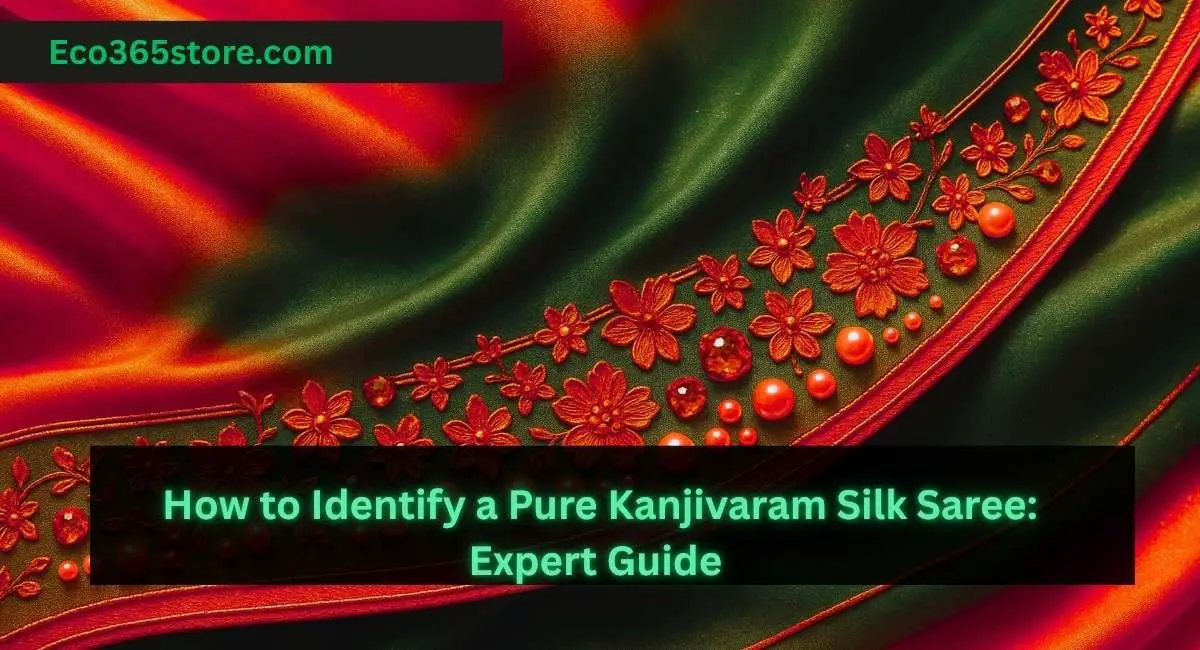How to identify pure Kanjivaram silk saree? With fakes and machine-made copies on the rise, this expert 2025 guide shows you practical, non-destructive ways to spot an authentic Kanchipuram silk saree. From the fabric feel and korvai join to zari tests, Silk Mark certification, weight, weave density, motifs, pricing, and seller credibility—use these simple checks to master pure silk saree identification and support real artisans.
Quick authenticity checklist (save this)
- Touch/feel: cool-then-warm, smooth yet firm; soft “snow” crunch when rubbed
- Certifications: Silk Mark tag (QR/hologram), Handloom Mark, GI-tag mention
- Zari: antique-gold tone, not overly shiny/plastic; scratch test on a loose thread
- Weave joins: korvai (body–border) and petni (pallu–body) visible on the reverse
- Weight/drape: dense, heavier hand; rich fall and volume
- Motifs: woven (not printed/embroidered), traditional temple, peacock, mango, kattam checks
- Price/seller: premium pricing, full disclosure of weave/zari/origin, invoice
How to Identify a Pure Kanjivaram Silk Saree?
1) The Fabric and Touch Test
Kanjivaram (Kanchipuram) silk is mulberry silk woven with high-density warp and weft, giving it a distinct hand-feel.
- Texture: Pure Kanjivaram silk feels smooth but firm (never plastic-slippery). It has body and bounce.
- Temperature: Real silk feels cool at first touch and warms against the skin in seconds.
- Crunch test: Gently rub the fabric near the pallu—pure silk makes a soft, “snow-like” crisp sound.
- Drape: It holds pleats beautifully and falls with weight; blends often feel limp or unnaturally slippery.

2) Check for the Silk Mark Tag
The Silk Mark Organization of India certifies genuine silk.
- What to look for:
- Silk Mark tag with hologram/QR and a unique code
- India Handloom Mark (optional but excellent) indicating handloom origin
- GI tag reference: “Kanchipuram Silk Saree” (a registered Geographical Indication)
- How to verify:
- Scan the Silk Mark QR or enter the unique number on the official portal/app
- Ask the store to show certification on invoice
- Note: Silk Mark confirms silk purity; it does not certify zari purity—check zari separately.
3) Examining the Zari Work
Traditional Kanjivaram sarees use real zari: pure silver thread gilded with gold (from Surat). Many modern pieces use “tested zari” (copper base). Know the difference:
- Look
- Real zari: antique, mellow gold—never neon-yellow or plastic-shiny
- Tested/synthetic zari: overly bright, brassy, or too uniform
- Feel
- Real zari threads feel slightly textured and substantial
- Cheap metallic/poly zari can feel wiry or plasticky
- Scratch test (do this on a loose end or the reverse of the border):
- Real/traditional zari often reveals a silk core (white or red) under the metal wrap
- Fakes show polyester/pink plastic filament
- Patina
- Real zari gently ages; it will not flake like foil
If you’re paying for real zari, ensure the invoice states “pure zari” (not just “zari”). Ask weight of zari or make (real vs tested).
4) The Korvai Join (Body and Border Connection)
A hallmark of authentic handloom Kanjivarams is the korvai technique:
- Body and border are woven separately and then interlocked by hand on the loom using a three-shuttle method.
- On the reverse of the border, you’ll see a clean, strong interlock line (tiny tooth-like joins).
- Petni (pallu join): Many true Kanjivarams also have the pallu woven separately and joined—look for a neat contrast join.
- Machine-made sarees usually lack these joins; borders look “printed-on” or seamlessly fused without interlocks.
5) Weight and Weave Density
Kanjivarams are prized for their dense weave and double-warp construction.
- Typical weight: about 600 g to 1 kg+ (heirloom, heavy zari pieces can exceed this)
- Hand-feel: compact weave with minimal sheerness; you shouldn’t see the hand clearly through the body (except lighter “soft silk” variants)
- Light “pure silk” claims with feathery weight often indicate blends or low-density weaves
6) Design and Motif Test
Authentic Kanjivarams feature woven—not printed—motifs and borders.
- Classic motifs: mayil (peacock), yaali, rudraksha, mango (paisley), gopuram/temple borders, annam (swan), chakra, checks (kattam), stripes (varisai), coin buttas
- Color: rich, deep hues with contrast borders and pallus; colors are dyed into yarn before weaving (no surface prints)
- Inspect closely: motifs should be integral to the weave; no ink edges or embroidery backing papers
7) The Burn Test (Use with Maximum Caution)
Only if you have a loose thread (never cut a drape):
- Pure silk burns slowly, smells like burnt hair, and leaves a brittle, fine grey ash you can crush
- Synthetic fibers melt, bead, and smell like plastic/chemicals
- Do this outdoors with tweezers and water handy; avoid if you’re unsure
Safer alternative: Take the saree to a reputable store or textile lab for a quick fiber check.
8) Cross-Check Price and Seller Credibility
Authentic Kanjivarams are premium because of labor, silk grade, and zari.
- Price ranges (India, 2025; approx):
- Tested zari: ₹10,000–₹40,000+
- Pure zari: ₹35,000–₹1,00,000+ (heirloom/bridal pieces can go higher)
- Reputed stores/boutiques:
- Nalli, Pothys, RMKV, Tulsi Silks, Deepam, Rathi, Kanakavalli, Sundari Silks, Kumaran Silks
- Ask for:
- Origin (Kanchipuram), weaver/cluster details, weave technique (korvai/petni), zari type (pure/tested), Silk Mark, return policy, and a detailed invoice
9) Pro Tips to Avoid Fake Sarees in 2025
- Always insist on a Silk Mark tag and a proper invoice
- Prefer sellers who disclose zari type clearly (pure vs tested) and mention korvai/petni
- Buy directly from Kanchipuram weavers’ co-ops or verified boutiques when possible
- Use the store’s video calls or high-res photos to inspect joins and zari before buying online
- Compare the selvedge: handloom edges show subtle irregularities (a good sign); powerloom edges look overly perfect
- For heirloom purchases, consider a certificate from a trusted textile expert or lab
Buying and care extras
- Store wrapped in muslin, away from sunlight; refold every few months to prevent permanent creases
- Dry clean sparingly; avoid spraying perfumes directly on zari
- Air the saree after use; avoid hanging by the shoulder for long periods—fold flat
Conclusion
Authentic Kanjivaram sarees are wearable heirlooms. With this pure Kanjivaram silk saree identification guide—touch and crunch sound, Silk Mark verification, real zari checks, korvai/petni joins, weight and weave density, traditional motifs, and credible pricing/sellers—you can confidently choose an authentic Kanchipuram silk saree. Support genuine weavers, ask the right questions, and make heritage-conscious purchases that honor the craft and last for generations.
How do I know if my Kanjivaram saree is handloom or machine-made?
Look for korvai/petni joins on the reverse, slight irregularities in weave (human touch), and the India Handloom Mark. Powerloom sarees lack hand joins and appear overly uniform.
What thread color indicates authentic zari?
Traditional real zari often wraps precious metal around a silk core (commonly white or red). Fake/synthetic zari frequently reveals polyester/pink filaments. Check only on a loose thread.
Are “soft silks” or lightweight variants pure Kanjivaram?
They can be. “Soft silk” usually means a lower denier silk or less dense weave, often with tested zari—lighter drape but still pure silk if certified. Confirm Silk Mark and weave details.
Can I test authenticity at home without damaging the saree?
Yes: touch test, crunch sound, korvai/petni joins, and zari visual checks are non-destructive. Verify Silk Mark via QR. Avoid burn tests unless you have a loose thread and know the safety steps.

Anamika is a passionate writer for Eco365Store.com, specializing in topics that inspire a cleaner, greener world. With expertise in home cleaning, recycling, and eco-friendly solutions, she crafts engaging and informative articles that help readers adopt sustainable practices in their daily lives.

